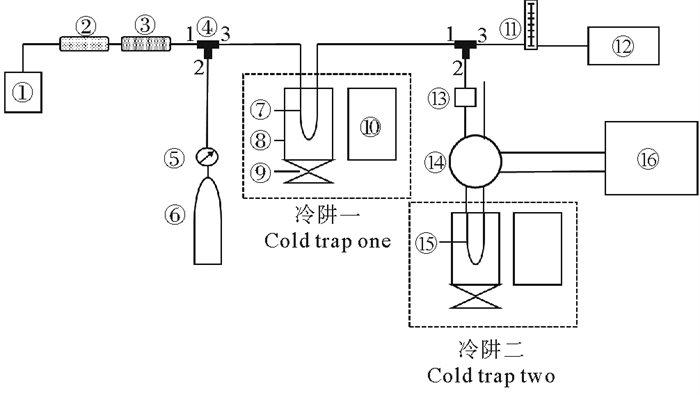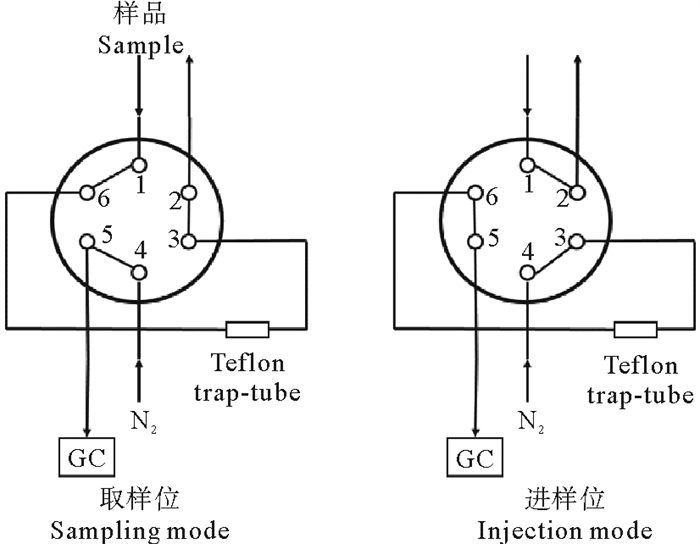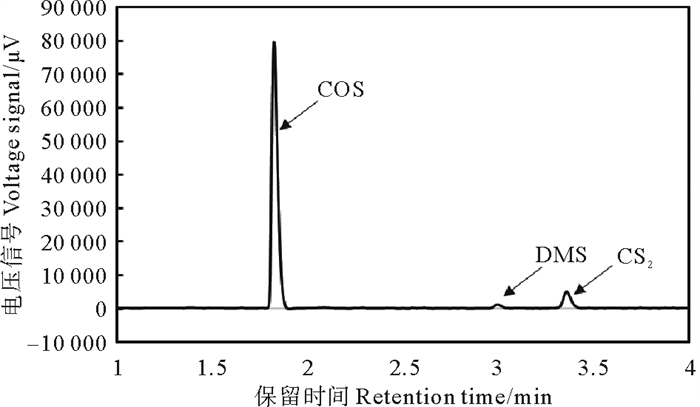挥发性硫化物(Volatile sulfur compounds,VSCs)主要包括羰基硫(Carbonyl sulfide,COS)、二甲基硫(Dimethyl sulfide,DMS)、二硫化碳(Carbon disulfide,CS2)、甲硫醇(Methyl mercaptan)和二甲基二硫(Dimethyl disulfide)等含硫有机化合物。这些挥发性含硫气体是一类分布最广、影响最突出的恶臭污染物[1],是中国《恶臭污染物控制标准》(GB 14554—1993)[2]中的受控物质。研究表明,VSCs对人的眼睛、皮肤和呼吸道均有强烈的刺激作用,大量吸入VSCs还会导致中枢神经系统抑制、恶心呕吐等症状[3]。VSCs氧化生成硫酸盐气溶胶,增加了大气中云凝结核,对大气环境和温室效应均产生重要影响[4]。因此,VSCs不仅对人类健康有影响[5],还与全球变暖、酸沉降和云组成密切相关,其中DMS能缓解温室效应而受到广泛的关注[6-7]。
VSCs人为来源主要是工业生产排放和化石燃料燃烧。VSCs自然来源有海洋、湿地、土壤、内陆水体、植物、沙漠和火山等,其中,海洋是VSCs排放的最重要的途径。VSCs主要来源于海水中的藻类等浮游生物,其释放的硫约占海水释放总硫的46%,并可通过分子扩散和涡流扩散的综合作用进入大气[8]。环境空气中VSCs浓度极低,浓度范围跨度大(ng·L-1~μg·L-1),具有易挥发、易吸附和气态寿命短等特点,因此测定前需经过富集和浓缩,才能满足仪器检出限的要求[9]。目前,VSCs主要的测定方法是气相色谱法[10],根据检测器不同,如质谱检测器[11-12]、火焰光度检测器[13-16]、硫化学发光检测器[17-18]、光离子化检测器[19-20]、脉冲火焰光度检测器[21]、氢火焰离子化检测器[22]等,测定结果会有差别。其中,火焰光度检测器因其价格低、选择性高,成为测定含硫化合物的首要选择。中国曾先后颁布了两种测定环境空气中有机硫化物的方法,即《空气质量硫化氢、甲硫醇、甲硫醚和二甲二硫的测定气相色谱法》(GB/T 14678—1993)[23]和《环境空气挥发性有机物的测定罐采样/气相色谱-支部发》(HJ 759—2015)[24]。但是,这两种检测方法的成本高、操作较复杂,且使用了液氧,存在一定的危险性。与气相色谱联用的富集浓缩方法主要有固相微萃取法[25]、低温吸附-热脱附方法[26-27]和三级冷阱低温浓缩法[9, 28]等。其中,三级冷阱低温浓缩法检出限较低,但存在标准限值的问题[13]。低温吸附-热脱附方法采样较繁琐,且吸附剂的吸附效果对不同含硫化合物存在差异。固相微萃取法可能存在竞争吸附、涂层吸附目标物、线性范围窄等问题[29]。目前,对大气中DMS的测定报道很多,对VSCs的多组分同时测定鲜有报道,这主要是由于大气环境中各组分VSCs的浓度低,含量差别较大,测定时分离比较困难。
本研究建立了二阶冷阱预浓缩气相色谱法测定大气环境中VSCs的方法。本方法针对大气样品浓度低、易吸附等特点,采用自制的二阶冷阱预浓缩装置结合气相色谱法进行分析,对预浓缩的条件进行优化,以满足环境空气测定需要,并尝试将此方法应用于胶州湾湿地不同植被区域挥发性硫化物气体的测定分析。该方法定性、定量准确,较之前的三阶冷阱低温预浓缩法检出限较高,但其具有操作简便,成本较低,易于推广等优势,能够满足日常大气环境样品的测定浓度范围,为野外环境大气研究提供了较好的技术支持。
1 材料与方法 1.1 仪器及试剂气相色谱仪(GC-2030,日本岛津);HP-5石英毛细色谱柱(美国安捷伦公司);火焰光度检测器(FPD);低噪音空气泵(QL-300,赛克赛斯);高纯氢气发生器(QLB,赛克赛斯);1 L Telder采样袋(大连德霖气体包装有限公司);吹扫-捕集前处理装置(自行设计),捕集管为不锈钢Tenax管(上海安谱科学仪器有限公司)和聚四氟乙烯管(上海安谱科学仪器有限公司);Nafion干燥管(Perma Pure, 美国Toms River公司);手动六通进样阀(美国VICI公司);进样注射器(100 mL, SGE, 澳大利亚);玻璃转子流量计(LZB-2,银环流量仪表有限公司);真空抽气泵(03 L-D,大连德霖气体包装有限公司)。
三种VSCs(COS、DMS、CS2)混合标准样品(100 μg·L-1,色谱纯,99.9%,北京明尼克分析仪器设备中心);氢氧化钠(分析纯,青岛市化学试剂厂);高氯酸镁(分析纯,国药集团化学试剂有限公司);高纯氮气(N2,99.999%,中国青岛豪森新能源公司);液氮(中国青岛豪森新能源公司)。
1.2 色谱分析条件色谱柱:HP-5 (3.2 mm, 3.0 m×1/8 mm);柱温:起始温度35 ℃;载气流速:1 mL·min-1;氢气流速:50 mL·min-1;空气流速:60 mL·min-1;解吸温度:100 ℃;解吸时间:3 min。
程序升温:初始温度35 ℃,保持5 min,以15 ℃·min-1的速率升温至150 ℃,保持5 min。
1.3 工作曲线绘制使用100 mL进样注射器定量移取10、20、50、100、200、300、400、500 mL浓度为100 μg·L-1标准气体于1 L Tedler采样袋中,充入氮气,得到浓度为1.0、2.0、5.0、10.0、20.0、30.0、40.0、50.0 μg·L-1的三种含硫气体标准系列。采用线性方程对峰面积的对数和浓度进行线性回归,建立工作曲线。
1.4 二阶冷阱预浓缩实验装置图 1描述了大气样品中VSCs的二阶冷阱预浓缩实验装置,其主要由两个三通阀控制两条不同通路的通止。其中,装有Tenax的不锈钢填充柱为冷阱一,Nafion干燥管为冷阱二。六通阀的取样及进样状态示意图如图 2所示。

|
(1.1 L Tedler采气袋;2. NaOH玻璃填充管;3. 无水Mg(ClO4)2玻璃填充管;4. 三通阀;5. 减压阀;6. 氮气钢瓶;7. Tenax不锈钢填充柱;8. 液氮杯;9. 升降台;10. 热水杯;11.流量计;12. 气泵;13. Nafion干燥器;14. 六通阀;15. Teflon捕集管;16. 气相色谱仪。1.1 L Tedler gas bag; 2. NaOH glass filled tube; 3. Anhydrous Mg(ClO4)2glass filled tube; 4. Three-way switch valve; 5. Relief valve; 6. N2 cylinde; 7. Tenax stainless steel filled column; 8. Liquid nitrogen trap; 9. Lifting platform; 10. Boiling water trap; 11. Flowmeter; 12. Gas pump; 13. Nafion drying tube; 14. Six-way switch valve; 15. Teflon trap-tube; 16. Gas chromatography.) 图 1 二阶冷阱预浓缩装置图 Fig. 1 Diagram of two-step trap concentrators |

|
图 2 六通阀进样和取样示意图 Fig. 2 Diagram of sampling mode and injection mode |
将装有气体样品的1 L Tedler采样袋与二阶冷阱预浓缩装置连接,转动两个三通阀连接1和3位,此时冷阱一处于捕集状态,冷阱二处于未连接状态。打开气泵开关,调节流量计流量为100 mL·min-1。气体在气泵动力下依次通过装有NaOH和无水Mg(ClO4)2的玻璃填充管,通过化学反应除去气体样品中的二氧化碳和水蒸气等气体。而后进入填充Tenax吸附剂的不锈钢管,并在-170 ℃条件下捕集7 min。随后分别转动两个三通阀连接2、3位和1、3位,转动六通阀至取样位,此时冷阱一处于解吸状态,冷阱二处于捕集状态。打开N2阀开关,将捕集气体后的Tenax不锈钢管放入装有100 ℃的热水中解吸3 min,N2携带待测气体进入Teflon捕集管,于-170 ℃下捕集3 min。而后关闭N2阀开关,将捕集后的Teflon捕集管放入装有100 ℃的热水中解吸2 min,同时转动六通阀至进样位,气体样品进入GC分析测定。
1.6 统计分析采用SPSS 23.0软件对两组数据进行F检验判断两组数据是否存在显著性差异(p < 0.05即可证明两组数据之间存在显著性差异)。
2 结果与讨论 2.1 预浓缩条件的确定将15 μg·L-1样品采集于1 L Telder采样袋中,气体在泵动力下进入二阶冷阱预浓缩装置,通过NaOH填充柱时二氧化碳与NaOH反应被去除,通过无水Mg(ClO4)2填充柱时水蒸气与无水Mg(ClO4)2反应从而达到去除效果,而后经过二阶冷阱富集及热水解吸,最后进入GC进行测定。通过设计正交实验(见表 1)确定冷阱一的最佳解吸温度及捕集时间。结果表明,冷阱一的解吸温度及捕集时间分别为100 ℃和7 min时,分析结果较好。冷阱二的最佳分析条件参照Yang等方法[30]的前处理条件,最佳分析条件列于表 2。三种VSCs气体的分离效果图如图 3所示,分离COS、DMS和CS2的保留时间分别为1.7、3.0和3.3 min,全部分离过程在4 min内完成,且三种物质达到完全分离。
|
|
表 1 第一阶冷阱预浓缩条件的正交试验 Table 1 Orthogonal experiment on preconcentration condition of the first-step trap concentrator |
|
|
表 2 二阶冷阱预浓缩装置的分析条件 Table 2 Analysis conditions of two-step trap concentrators |

|
图 3 气相色谱图 Fig. 3 Gas chromatogram diagram |
根据1.3步骤进行三种VSCs标准气体浓度系列的分析测定,并建立工作曲线。三种VSCs气体的标准曲线的线性回归方程及相关性系数如图 4所示。由图可知,在标准系列的浓度范围内,三种VSCs气体的气相色谱峰面积的对数与质量浓度均呈线性关系,且相关性系数均大于90.0%。

|
图 4 线性回归方程的拟合结果 Fig. 4 The fitting results of linear regression equation for COS(a), DMS(b) and CS2(c) |
在所选择的最佳实验条件下,对浓度为15 μg·L-1的VSCs样品进行5次平行测定,分析结果如表 3所示。通过计算得出方法的相对标准偏差(RSD)为0.43%~1.11%。
|
|
表 3 方法的精密度及检出限 Table 3 Precision and detection limit of the method |
在低浓度范围内选三个浓度(C1、C2和C3),对每一个浓度水平分别重复测定,求出各浓度水平的标准偏差S1、S2和S3, 再用线性回归法做出拟合曲线,延长该线与纵坐标相交于S0,3S0即为方法的检出限。在所选择的最佳实验条件下,对8、10和12 μg·L-1的标准气体进行检测,计算得出方法的检出限实验结果见表 3。由表 3可知,COS、DMS和CS2的检出限分别为2.58、1.70和2.51 μg·L-1。此检测范围能够满足环境大气样品的分析检测要求。
2.3.3 加标回收率向配制好的模拟气体中加入混合标准气体,分别配制成40和8 μg·L-1高、低两个浓度系列的样品,每个样品平行测定3次,计算得加标回收率及相对标准偏差(见表 4)。由表 4可知,三种VSCs气体在高、低浓度下的加标回收率分别为100.7%~102.3%和96.7%~137.2%,除了DMS外,相对标准偏差均在5.0%以内。一般对于挥发性有机物的测量精度要求在20%以内,加标回收率可在80%~120%。因此,本方法可满足挥发性有机物的分析要求。
|
|
表 4 方法的加标回收率 Table 4 Recovery rate of the method |
按本研究方法对某地大气中的三种VSCs进行测定,并将其结果与气质联用法(7890A/5975C, 美国安捷伦公司)[8]的测定结果进行对比(见表 5)。由SPSS 23.0软件对两组数据进行F检验,由表 5可知,三种VSCs的F检验显著性结果均符合p>0.05,因此,其检测结果不存在显著性差异。因此,本文所述方法可以应用于环境空气中VSCs的测定。
|
|
表 5 两种方法对样品VSCs浓度平行测定结果 Table 5 VSCs concentrations of same sample detected by two methods |
利用本研究方法测定胶州湾湿地三种不同植被类型(互花米草、碱蓬和光滩)区域大气样品中三种VSCs的浓度。将1 L Tedler采样袋用高纯氮气清洗多次,在取样现场使用真空抽气泵将环境空气采集到采样袋中,采满后将密封阀拧紧,阴凉处保存并带回实验室,于24 h内完成测定。实验室分析时,将气袋与二阶冷阱装置的入口连接进行测定,分析结果如表 6所示。由表 6可知,互花米草区域中三种VSCs气体均能检测出,其中,DMS的浓度最高,为10.15 μg·L-1,其次为CS2(4.09 μg·L-1),COS的浓度最低(3.19 μg·L-1)。碱蓬区域中DMS的浓度为3.12 μg·L-1,COS和CS2均未检出。光滩区域DMS和CS2的浓度分别为6.21和2.95 μg·L-1,COS仍未检出。
|
|
表 6 胶州湾湿地不同植被区域大气中VSCs的浓度 Table 6 The concentrations of VSCs in the atmosphere in different vegetation areas of the Jiaozhou Bay wetland |
本研究对二阶冷阱预浓缩法测定不同区域大气中VSCs的前处理条件进行了优化。在最佳实验条件下,三种VSCs气体(COS、DMS和CS2)峰面积的对数与质量浓度具有良好的线性关系,相关性系数R2均大于90%,相对标准偏差分别为0.43%~1.11%,精密度良好,检出限为1.70~2.58 μg·L-1,高、低两种浓度的加标回收率分别为100.7%~102.3%和96.7%~137.2%,除了DMS外,相对标准偏差均在5.0%以内。采用本方法测定了胶州湾湿地互花米草、碱蓬和光滩区域大气中的三种VSCs气体的浓度。本法与其他方法相比具有操作简便、成本低等特点,可应用于不同环境空气中VSCs的测量,有助于开展环境空气中VSCs产生及迁移过程的研究。但该方法的局限之处在于只能测定大气中的VSCs的浓度但无法实现VSCs的实时测量,因此未来还需要对大气中VSCs的测定方法进行更深入的研究。
| [1] |
王连生, 王艮, 韩萌, 等. 天津市城市垃圾臭气成分谱[J]. 城市环境与城市生态, 2009, 22(2): 19-23. Wang L S, Wang G, Han M, et al. Odor ingredient spectrum of urban trash in Tianjin[J]. Urban Environment & Urban Ecology, 2009, 22(2): 19-23. (  0) 0) |
| [2] |
GB 14554-1993. 恶臭污染物排放标准[S]. GB 14554-1993. Emission Standards for Odor Pollutants[S]. (  0) 0) |
| [3] |
崔连喜, 王艳丽. "吸附管采样-热脱附-气相色谱-质谱法"测定环境空气中5种有机硫化物[J]. 化工环保, 2021, 41(4): 518-523. Cui L X, Wang Y L. Determination of 5 organic sulfides in ambient air by adsorption tube sampling-thermal desorption-gas chromatography-mass spectrometry[J]. Environmental Protection of Chemical Industry, 2021, 41(4): 518-523. DOI:10.3969/j.issn.1006-1878.2021.04.019 (  0) 0) |
| [4] |
Andreae M O, Crutzen P J. Atmospheric aerosols: Biogeochemical sources and role in atmospheric chemistry[J]. Science, 1997, 276: 1052-1058. DOI:10.1126/science.276.5315.1052 (  0) 0) |
| [5] |
Susaya J, Kim K H, Phan N T, et al. Assessment of reduced sulfur compounds in ambient air as malodor components in an urban area[J]. Atmospheric Environment, 2011, 45(20): 3381-3390. DOI:10.1016/j.atmosenv.2011.03.051 (  0) 0) |
| [6] |
Berry J, Wolf A, Campbell J E, et al. A coupled model of the global cycles of carbonyl sulfide and CO2: A possible new window on the carbon cycle[J]. Journal of Geophysical Research: Biogeosciences, 2013, 118(2): 842-852. DOI:10.1002/jgrg.20068 (  0) 0) |
| [7] |
Launois T, Belviso S, Bopp L, et al. A new model for the global biogeochemical cycle of carbonyl sulfide - Part 1: Assessment of direct marine emissions with an oceanic general circulation and biogeochemistry model[J]. Atmospheric Chemistry and Physics, 2015, 15(5): 2295-2312. DOI:10.5194/acp-15-2295-2015 (  0) 0) |
| [8] |
朱蓉, 张洪海, 杨桂朋, 等. 海水和大气中挥发性硫化物分析方法的研究[J]. 分析化学, 2017, 45(10): 1504-1510. Zhu R, Zhang H H, Yang G P, et al. Determination of volatile sulfur compounds in seawater and atmosphere[J]. Chinese Journal of Analytical Chemistry, 2017, 45(10): 1504-1510. DOI:10.11895/j.issn.0253-3820.170291 (  0) 0) |
| [9] |
徐能斌, 朱丽波, 应红梅, 等. 环境空气中痕量挥发性有机硫监测分析方法研究[J]. 中国环境监测, 2004, 20(2): 30-32. Xu N B, Zhu L B, Ying H M, et al. Determination of trace volatile organic sulfur compounds in environmental air by gas chromatography and mass spectrometry coupled preconcentration techniques method[J]. Environmental Monitoring in China, 2004, 20(2): 30-32. DOI:10.3969/j.issn.1002-6002.2004.02.009 (  0) 0) |
| [10] |
程正鹏, 张洪彬. 气相色谱法分析含硫恶臭物质综述[J]. 化学分析计量, 2021, 30(5): 89-95. Cheng Z P, Zhang H B. Review of detection of sulfur containing malodorous substances by gas chromatography[J]. Chemical Analysis and Meterage, 2021, 30(5): 89-95. (  0) 0) |
| [11] |
Ras M R, Borrull F, Marcé R M, et al. Determination of volatile organic sulfur compounds in the air at sewage management areas by thermal desorption and gas chromatography-mass spectrometry[J]. Talanta, 2008, 74(4): 562-569. DOI:10.1016/j.talanta.2007.06.017 (  0) 0) |
| [12] |
丁岚, 钟岩. 气相色谱质谱联用测定环境空气中挥发性恶臭硫化物[J]. 环保科技, 2017, 27(1): 37-40. Ding L, Zhong Y. Determination of volatile odor stench sulfide in air by Gas Chromatography-Mas Spectrometry[J]. Environmental Protection and Technology, 2017, 27(1): 37-40. (  0) 0) |
| [13] |
沈秀娥, 常淼, 刘保献, 等. 大气预浓缩仪-GC/FPD测定环境空气中的痕量硫化物[J]. 中国环境监测, 2015, 31(6): 103-108. Shen X E, Chang M, Liu B X, et al. Determination of trace sulfur compounds in environmental air by gc/fpd coupled the air preconcentrations[J]. Environmental Monitoring in China, 2015, 31(6): 103-108. DOI:10.3969/j.issn.1002-6002.2015.06.022 (  0) 0) |
| [14] |
杨晓辉, 徐勇, 张桢, 等. 利用在线气相色谱技术监控空气中的恶臭硫化物[J]. 环境化学, 2018, 37(2): 371-374. Yang X H, Xu Y, Zhang Z, et al. The on-line monitoring of sulfur compounds in air by gas chromatography[J]. Environmental Chemistry, 2018, 37(2): 371-374. (  0) 0) |
| [15] |
赵起越, 陈寅宝, 王鑫, 等. 浓缩富集-气相色谱-质谱火焰光度检测器联用测定厂界大气中10种硫化物[J]. 干旱环境监测, 2018, 32(4): 145-151. Zhao Q Y, Chen Y B, Wang X, et al. Determination of 10 sulfides in plant atmosphere by air pre - concentrations coupled with gas chromatography - mass spectrometry and flame photometric detector[J]. Arid Environmental Monitoring, 2018, 32(4): 145-151. (  0) 0) |
| [16] |
高艳秋, 罗鹏, 方华, 等. 预富集气相色谱法检测气体中痕量硫化物[J]. 上海计量测试, 2019, 46(4): 15-21. Gao Y Q, Luo P, Fang H, et al. Determination of trace sulfide in gas preconcentration-gas chromatography[J]. Shanghai Measurement and Testing, 2019, 46(4): 15-21. (  0) 0) |
| [17] |
李志昂, 潘义, 周鑫, 等. 硫化学发光气相色谱法在气体分析中应用研究[J]. 化学研究与应用, 2019, 31(9): 1623-1628. Li Z Y, Pan Y, Zhou X, et al. Application of sulfur chemiluminescence gas chromatography in gas analysis[J]. Chemical Research and Application, 2019, 31(9): 1623-1628. (  0) 0) |
| [18] |
刘明星, 刘泽龙, 李颖, 等. 固相萃取法/全二维气相色谱-飞行时间质谱测定柴油及其加氢产品中的含硫化合物[J]. 石油炼制与化工, 2020, 51(4): 96-104. Liu M X, Liu Z L, Li Y, et al. Identification and characterization of sulfur compounds in diesel and its hydrogenation products by solid phase extraction/comprehensive two-dimensional gas chromatography coupled with time-of-flight mass spectrometry[J]. Petroleum Procession and Petrochemicals, 2020, 51(4): 96-104. (  0) 0) |
| [19] |
李俊成, 张思祥, 周围, 等. 基于微气相色谱技术的含硫恶臭气体检测[J]. 现代化工, 2016, 36(12): 183-187. Li J C, Zhang S X, Zhou W, et al. Detection of sulfur containing odorous gas based on micro-gas chromatography technology[J]. Modern Chemical Industry, 2016, 36(12): 183-187. (  0) 0) |
| [20] |
王晓辰, 杨申昊, 邓维, 等. 恶臭气体中含硫组分的气相色谱快速检测系统研究[J]. 分析试验室, 2018, 37(8): 973-977. Wang X C, Yang S H, Deng W, et al. The research to fast detection system of sulfur-containing odorous gas mixture by capillary gas chromatography[J]. Chinese Journal of Analysis Laboratory, 2018, 37(8): 973-977. (  0) 0) |
| [21] |
邓冰. 气相色谱脉冲火焰光度检测器测定炼厂气中微量硫化物[J]. 杭州化工, 2014, 44(3): 30-33. Deng B. Determination of trace sulfide in refinery gas with GC-PFPD method[J]. Technology & Economics in Petrochemicals, 2014, 44(3): 30-33. (  0) 0) |
| [22] |
马利霞, 蔡旺锋, 陈益清, 等. 低浓度有机硫恶臭物质的采样分析方法[J]. 环境工程学报, 2016, 10(10): 5833-5839. Ma L X, Cai W F, Chen Y Q, et al. Sampling and measurement method research on trace-level odor organic sulfur compounds[J]. Chinese Journal of Environmental Engineering, 2016, 10(10): 5833-5839. (  0) 0) |
| [23] |
国家环境保护局, 国家技术监督局. GB/T 14678—1993空气质量硫化氢、甲硫醇、甲硫醚和二甲二硫的测定气相色谱法[S]. 北京: 中国标准出版社, 1993. National Environmental Protection Agency, General Adminstration of Quality Supervision, Inspection and Quarantine. GB/T 14678—1993 Air quality-Determination of Sulfuretted Hydrogen, Methyl Sulfhydryl, Dimethyl Sulfide and Dimethyl Disulfide-Gas Chromatography[S]. Beijing: China Standard Press, 1993. (  0) 0) |
| [24] |
HJ 759-2015. 环境空气挥发性有机物的测定罐采样/气相色谱-质谱法[S]. HJ 759-2015. Ambient air-Determination of Volatile Organic Compounds-Collected By Specially-Prepared Canistersand Analyzed by Gas Chromatography/mass Spectrometry[S]. (  0) 0) |
| [25] |
Nielsen A T, Jonsson S. Trace determination of volatile sulfur compounds by solid-phase microextraction and GC-MS[J]. Analyst, 2002, 127(8): 1045-1049. (  0) 0) |
| [26] |
李新华, 刘景双, 贾益群, 等. 低温吸附、热解吸气相色谱法测定痕量气体硫化氢[J]. 分析测试学报, 2006, 25(3): 68-69. Li X H, Liu J S, Jia Y Q, et al. Determination of trace hydrogen sulfide by cryogenic adsorption-thermal desorption gas chromatography[J]. Journal of Instrumental Analysis, 2006, 25(3): 68-69. (  0) 0) |
| [27] |
李娟, 章勇, 丁曦宁, 等. 热脱附/气相色谱法测定空气中含硫化合物[J]. 环境监测管理与技术, 2009, 21(6): 44-46. Li J, Zhang Y, Ding X N, et al. Determination of organic sulfur compounds in air by GC/PFPD with thermal desorption[J]. The Administration and Technique of Environmental Monitoring, 2009, 21(6): 44-46. (  0) 0) |
| [28] |
朱海俭, 黄学敏, 曹利, 等. 预浓缩与GC-MS联用分析垃圾填埋场恶臭气体[J]. 中国环境监测, 2012, 28(4): 91-94. Zhu H J, Huang X M, Cao L, et al. Determination of landfill gas by gas chromatography-mass spectrometer coupled preconcentration techniques method[J]. Environmental Monitoring in China, 2012, 28(4): 91-94. (  0) 0) |
| [29] |
张月琴, 杨海鹰, 吴淑琪, 等. 大气中痕量硫化物的富集及其检测进展[J]. 现代科学仪器, 2005, 66(6): 16-20. Zhang Y Q, Yang H Y, Wu S Q, et al. The advance of the enriching and determining methods for sulphur compounds in air[J]. Modern Scientific Instruments, 2005, 66(6): 16-20. (  0) 0) |
| [30] |
Yang G P, Li L, Qi J L, et al. Dimethyl sulfide in the surface water of the East China Sea[J]. Continental Shelf Research, 2000, 20(1): 69-82. (  0) 0) |
 2023, Vol. 53
2023, Vol. 53


